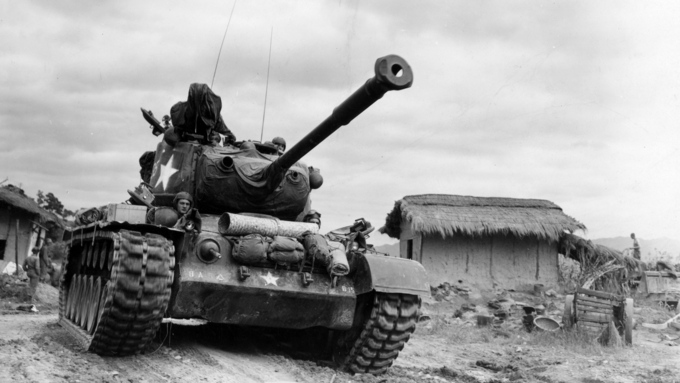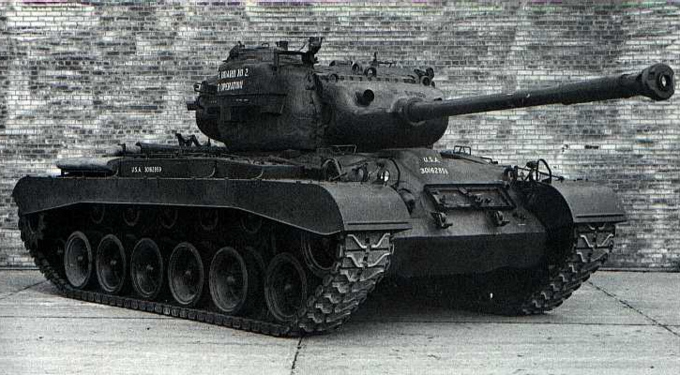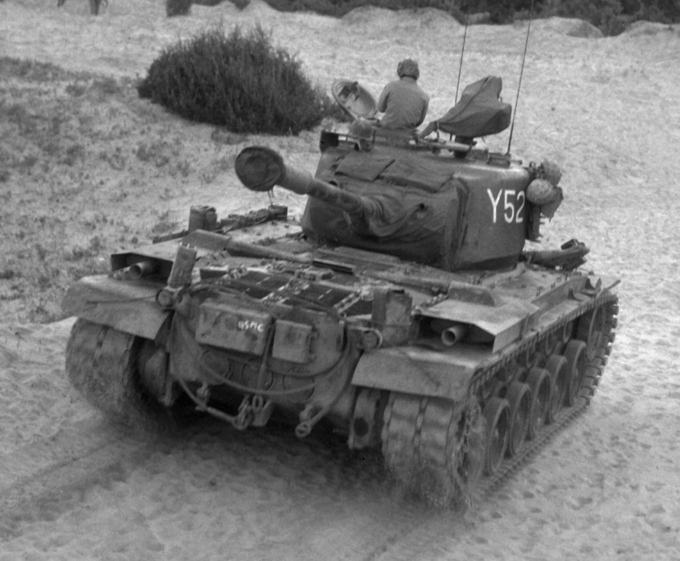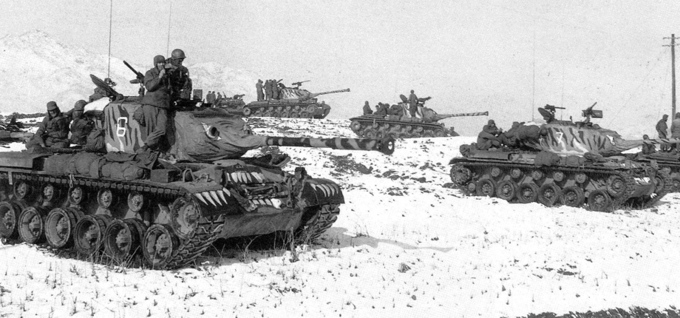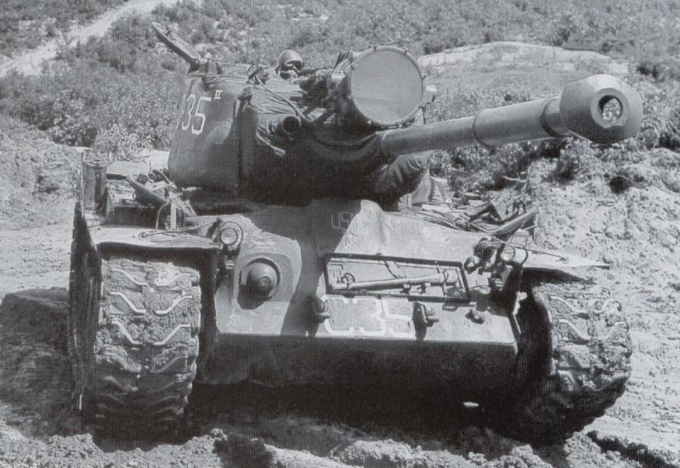The M46 Patton emerged from the modernization of the M26 Pershing to address the evolving needs of the US Army. With significant upgrades in engine power, transmission, and firepower, the M46 would play a crucial role during the Korean War. Despite technical challenges, the M46’s deployment marked a significant advancement in tank technology, bridging the gap between World War II designs and the more modern tanks that followed.
M26 Pershing Modernization
At the end of World War II, the US Army's most modern tank design was the M26 Pershing heavy tank. The M26 was remarkably better than the M4A3 (76) W HVSS Sherman tank in terms of armor and gun but was deficient in engine power as it was around ten tons heavier than the M4A3 but retained the same 500 horsepower Ford engine. When tank production was halted in October 1945, the US Army had 2,212 M26s in inventory. As the US Army reorganized and specified their needs for the post war period, which included the reclassification of the M26 from a heavy tank to a medium tank in May 1946, the US Army sought the procurement of new tanks to make up the post-war tank fleet. However, the demilitarization and budget cuts with World War II's end heavily constrained the US Army's tank development and procurement programs. Stuck with what they had; the US Army began looking into modernizing the M26s to turn them into their desired postwar tank.
The M26E2 modernization program began in January 1948. As the engine was the biggest issue with the M26 Pershing, it and the transmission became the primary focus of the modernization program. Continental Motors Corporation, which was developing an engine specified by Ordnance Committee and the Tank Engine Committee since 22 July 1943, produced the AV-1790-1 engine that has significantly more horsepower than the Ford engine. Continental's AV-1790-1 engine was chosen to become part of the modernization program. The transmission was upgraded to a General Motors (GM) CD-850-1 cross drive design, a transmission design that was considered for US tank designs as far back in April 1943 during trials with the T20 tank. The cross-drive transmission was beneficial as it was almost twice as short as the original M26 transmission yet is able to perform the function of a transmission, steering control, and vehicle brake. Firepower improvements was also considered, with the 90 mm T54 gun as a possible upgrade option. However, this was cancelled as the 90 mm T54 introduced a new type of ammunition into the logistics train, and focus was put into improving the current 90 mm M3 in the M26. This became upgraded into the 90 mm M3A1 which saw the addition of a bore evacuator and a new single-baffle muzzle brake design.
By May 1948, a complete M26E2 tank (registration number 3012420) was completed and shipped to the Aberdeen Proving Grounds. Technical issues led to further improvements in the tank's components. In fiscal year 1948, the US authorized ten M26E2 tanks, with the program now designated as the medium tank T40. Changes were made to the M26 chassis for the modernization, most notably the additions of mufflers on the top of each side's fender for the engine exhaust pipes and a small track tension idler wheel between the rear sprocket and the rear road wheel. By 30 July 1948, the Ordnance Technical Committee Minutes (OTCM or OCM) 32312 designated the T40 tanks as the M46 medium tank, with the nickname "General Patton" after General George S. Patton. A production run of 800 tanks was authorized in 1949 fiscal year, with the hopes of 1,215 M26 tanks being converted to M46 standards in the 1950 fiscal year. The first M46 would roll off the production lines in November 1949, now powered by a Continental AV-1790-5A with a GM CD-850-3 transmission.
Korean War Breaks Out
As the US Army began ramping up production and conversion programs for the M46 tank, the Korean War began in June 1950. The Korean War's demand for armor caused tanks in all US Army depots and stockpiles to be reactivated and sent to the Korean peninsula. This unfortunately means that the M26 Pershing tanks meant to be converted to M46s were limited. The M46, of which only 319 units were produced by the Korean War's outbreak, fell into a quagmire within the US Army of not having enough M26s available to convert, but being outdated enough to not warrant the production of new units. In an effort to get new, modern tanks ready as quick as possible, it was suggested in July 1950 that the turret of an ongoing medium tank development, the T42, be placed onto the M46 hull. A pilot model was produced and shipped to Aberdeen Proving Ground on March 1951, designated M46E1. Following further modifications, this combination would culminate into the M47 tank.
Continued field testing with the M46 and the development of the T42 led to more improvements in the M46 design. Initially designated the "M46(New)", this new improvement included a more efficient oil cooling system, new instrument panel, new hull wiring, improved brakes, and a new fire extinguishing system. A new Continental AV-1790-5B and General Motors CD-850-4 transmission was also designed that was interchangeable between the improved M46 and the T42. The "M46(New)" was eventually redesignated to M46A1 when it went into production with a contract for 360 units on 01 April 1951. These M46A1 tanks started production from registration numbers 30163849 and up.
M46 in Service
As the Korean War demanded large numbers of tanks, the M46 Pattons were sent alongside M4A3 Shermans and M26 Pershings into the fray. The first unit with M46 tanks in Korea was the 6th Tank Battalion, which was unloaded into Pusan on 08 August 1950. The 6th Tank Battalion was soon followed by the 64th Tank Battalion on August 13th that was also equipped with M46s. Of the 1,326 American tanks sent to Korea, 200 were M46 Pattons while the rest were 309 M26 Pershings, 679 M4A3 (76) W HVSS Shermans and 138 M24 Chaffees.
The M46s benefitted from the more powerful powertrain to be more maneuverable than the M26 Pershing in the theater. However, the rapid development and fielding of the M46 showed technical problems in the field, with breakdowns associated to problems with components like the engine oil cooler fan. Nevertheless, the M46s were used effectively before and after the Chinese became involved with the Korean War, with 97 M46s in the Eight Army being involved with the January 1951 counter-offensive against the Chinese. One feature that was tested with the M46 Pattons was the attachment of a searchlight onto the tank to have better battlefield illumination for night battles. The original idea called for taking a M4A3 Sherman tank to be designed with a special turret accommodating a searchlight and a 75 mm gun, designated the T52 searchlight tank. An alternative solution was devised by attaching searchlights atop tank cannons, which proved to be cheap enough to not warrant a new tank design and convenient enough for any tank to be equipped with a searchlight.
The Korean War would end in a ceasefire brought about by an armistice. Due to the armistice dictating the restrictions of weapon imports into the region, the M46s continued to serve there in American hands as America developed their newer tank models. By 14 February 1957, OTCM 36468 would declare the M46 and M46A1 as obsolete, with the Americans only using the M46 in Korea until they are retired from lack of spare parts.
After the end of the Korean War, the M46 became part of America's weapon exports to Europe. However, as America's tank productions churn out the M47 Patton II tank, the value of the M26 and M46 for combat-ready units was not high. The M26 and M46 tanks would be exported as training vehicles to prepare crew for the receiving of M47s. Though France, Belgium, and Italy received M26s for this role, Belgium would also receive eight M46A1 that were used as training vehicles at Leopoldsburg tank training center. Many more M46s would find themselves as range targets.
Bibliography
- Connor, Arthur W., Jr. 1992. "The Armor Debacle in Korea, 1950: Implications for Today". The US Army War College Quarterly, Parameters 22 (1): 66-76. Article (Archive)
- Hunnicutt, Richard P. 1971. Pershing: A History of the Medium Tank M20 Series. Berkeley, CA: Feist Publications.
- Hunnicutt, Richard P. 1984. Patton: A History of the American Main Battle Tank: Volume I. Novato, CA: Presidio Press.
- Pike, John. 2021. "M46 Patton." Global Security. Last modified January 07, 2021. Website (Archive).
- Zaloga, Steven J. 2000. M26/M46 Pershing Tank 1943-1953. Oxford: Osprey Publishing Ltd.
